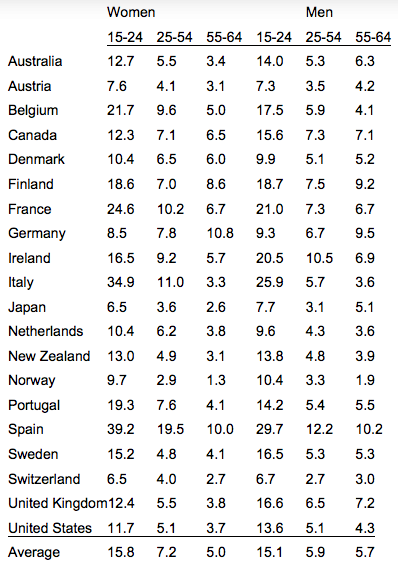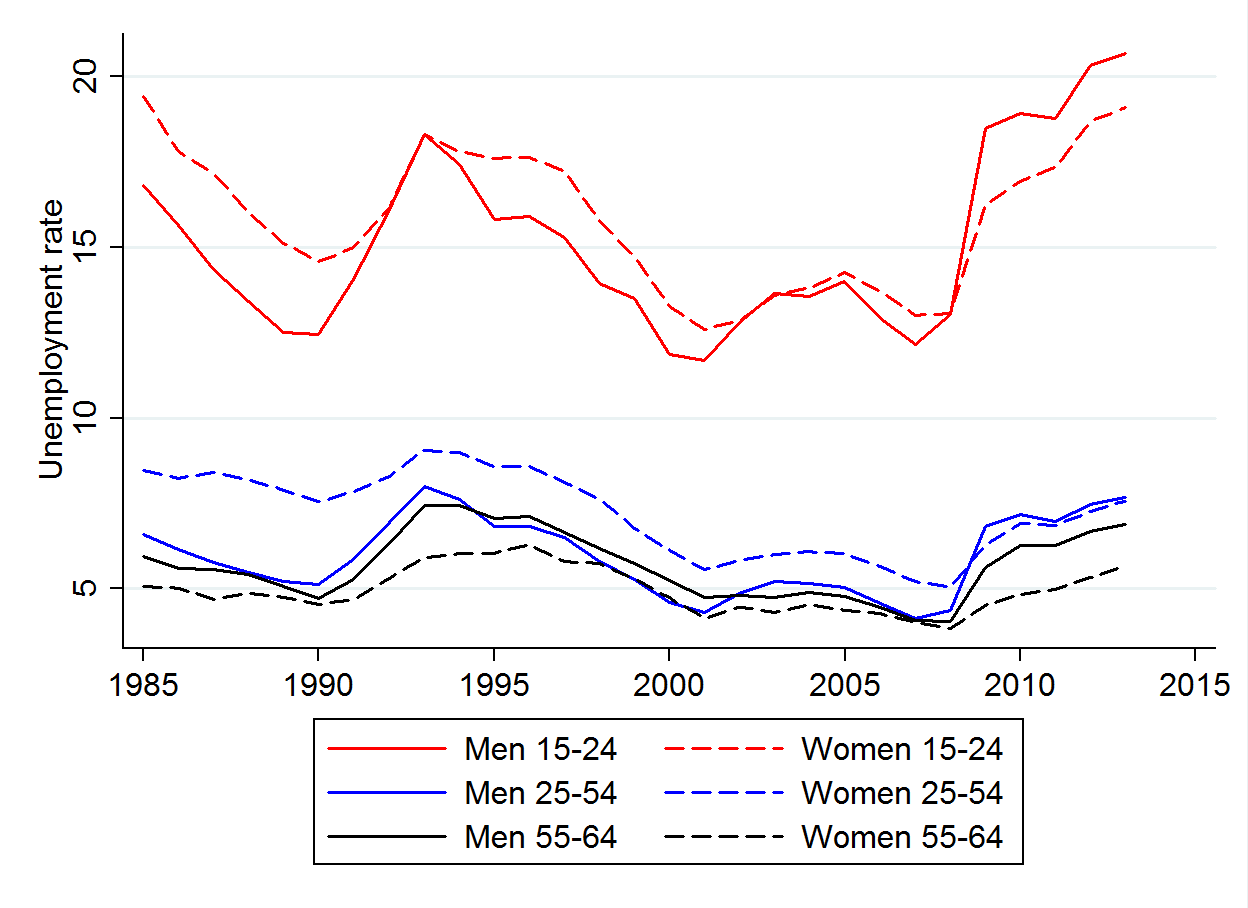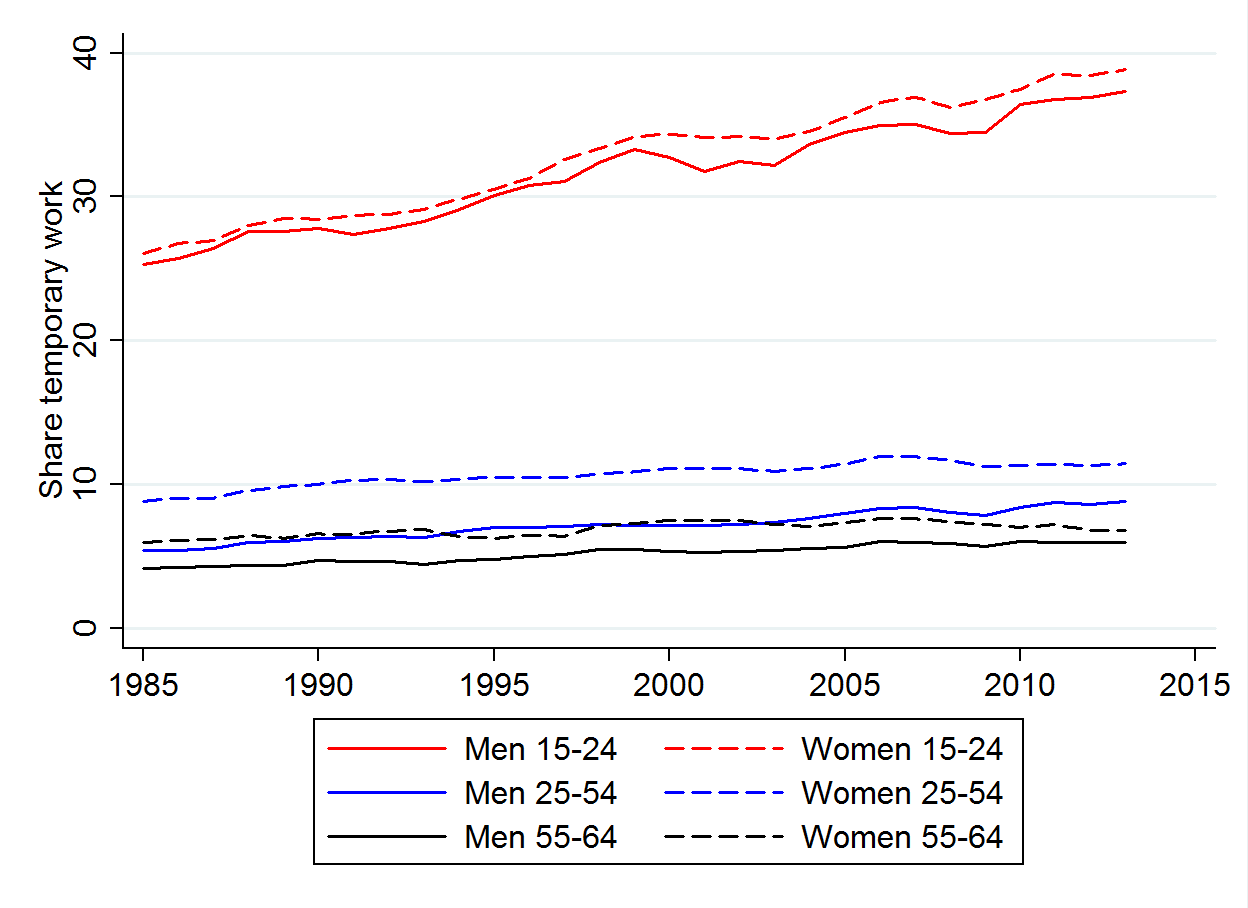Fluctuations in unemployment and growth go hand in hand, and there are numerous empirical studies of the relationship between the two. The simplest and most widely cited relationship is Okun’s law – the relationship between unemployment and the cyclical component of GDP (i.e. the output gap). It is a reduced-form relationship that has underpinned numerous academic and policy discussions about growth and employment. Using cross-country time series data, we revisit Okun’s relationship. We investigate how the relationship between the (equilibrium) unemployment rate, the output gap, and labour market institutions differ depending upon age and gender. This is an important extension as the determinants of the equilibrium unemployment rate and the size of the Okun coefficient are likely to vary across age groups and across gender.
It is well-known that unemployment rates of young workers are on average higher and more volatile than unemployment rates of prime age and old workers (Bell and Blanchflower 2011). There are various reasons why Okun’s relationship may be age-specific. Compared to older workers, young workers have less company-specific skills and less dismissal protection (Dunsch 2015, O’Higgins 1997). Furthermore, to the extent that age is related to experience, Becker (1964) argues that the amount of specific training affects the incentives of firms and workers to separate – an idea developed by Cairo and Cajner (2014). Since the labour market position of females is different from the labour market position of males it is likely that Okun’s relationship is both age and gender-specific. There are three studies that have investigated age-specific versions of Okun’s law. Hutengs and Stadtmann (2013) estimated Okun’s relationship over the period 1984-2011 for 11 Eurozone countries and five age groups. Zanin (2014) studied five age cohorts by gender for 33 OECD countries over the period 1998-2012. Hutengs and Stadtmann (2014) estimated Okun’s relationship for five Scandinavian countries and five age groups over the period 1984-2011. All studies found that the change in unemployment is more sensitive to economic growth for young workers than for prime age and older workers. Our study contributes to this literature by also considering the effects of labour market institutional factors.
Stylised developments and differences
Because of data availability, the focus of our analysis is on 20 OECD countries over the period 1985-2013. There are five countries outside Europe (Australia, Canada, Japan, New Zealand, and the US) and 15 countries in Europe, of which ten adopted the euro (Austria, Belgium, Finland, France, Germany, Ireland, Italy, Netherlands, Portugal and Spain) and five did not (Denmark, Norway, Sweden, Switzerland and the UK).
There are large and persistent differences in the labour market characteristics of workers according to their age and gender. Table 1 provides an overview of country-specific averages of the unemployment rates by age and gender. Clearly, there are substantial differences both within and between countries. Youth unemployment rates are on average twice as high as unemployment rates among prime age workers whereas unemployment rates among old men and women (i.e. those aged over 54 years) are on average the lowest. There are differences between unemployment rates of young men and young women (i.e. those aged under 24 years) but the dominant difference amongst the young is according to country, not gender. Whereas on average youth unemployment rates in Austria, Germany, Japan, and Switzerland are below 10%, they are above 25% for young men and women in Italy and Spain. There are also differences for prime age workers, but they are substantially smaller in absolute terms. The lowest unemployment rates over the time period for prime age men and women are in Norway and Japan (below 4%). The highest unemployment rates for old men are in Spain with 10.2%, and for old women in Germany with almost 11%, while the lowest rates for old men and women are in Norway (both less than 2%).
Table 1. Country-specific unemployment rates by age and gender; average 1985-2013 (%)
Notes: The data for Austria refer to the period from 1994 onwards, for New Zealand from 1986 onwards and for Switzerland from 1991 onwards.
Panel (a) of Figure 1 shows the evolution of unemployment rates over the period 1985-2013 averaged for the 20 countries and disaggregated by age and gender. The unemployment rates shown in panel (a) are very different depending on age. The unemployment rates of young individuals are by far the highest and they fluctuate much more than the unemployment rates of prime age and old individuals. Conditional on age, the differences between men and women are small. As shown in panel (b) of Figure 1, the share of temporary workers is substantially higher among young workers and also increasing much faster than among prime age and older workers. The increase in the share of temporary workers over the sample period is on average about 10 percentage-point higher from 25–35%.
Figure 1. Unemployment rates and shares of temporary workers by age and gender – averaged over 20 countries; 1985-2013
a. Unemployment rates
b. Shares of temporary workers
Okun’s relationship by age and gender
We allow labour market institutions to affect unemployment, thereby allowing the equilibrium rates of unemployment and the effect of the output gap on the unemployment rate to be time-varying. We investigate the effects of union density, wage coordination, unemployment benefits replacement rates, tax wedges, and terms of trade on the unemployment rates. We find that union density, UI replacement rates, and the tax wedge have a positive effect on unemployment rates, while wage coordination and terms of trade have a negative effect. We also find that the effect of output-gaps on unemployment rates is stronger if the share of temporary workers is higher.
We also allow labour market institutions to affect the separate Okun’s relationships by age and gender. Our main findings are as follows (for details, see Dixon et al. 2016). The share of temporary workers has a significant effect on the gap-coefficient, except for older workers. This may be due to the low share of old temporary workers as well as with the relative stability of that share. The parameter estimate for the interaction term between the output gap and their share of temporary workers is smaller for young workers but one has to take into account the fact that the share of temporary workers for young workers is much higher and increasing. Finally, the effects of labour market institutions on the unemployment rates are very similar for all groups, but some of the magnitudes are age- and gender-specific. In particular, a high level of wage coordination seems to be mostly beneficial for young workers. A possible explanation is that a high level of wage coordination more strongly internalises the unemployment effects of wage negotiations. Since youngsters suffer high unemployment rates, they may be more affected by a high level of wage negotiations – that is, for them the dampening effect on unemployment is strongest.
Conclusions
The analysis at the age-gender level, taken in conjunction with findings about labour-institutional factors, allows us to draw some policy implications. We show that equilibrium unemployment rates are positively related to union density, the UI replacement rate and the tax wedge and negatively related to the level of wage coordination and the terms of trade. We also find that the effects of changes in the output gap on the unemployment rate decreases with age. From this we infer that an increase in economic growth will not only reduce the overall unemployment rate but it will also bring about a more than proportional decline in the youth unemployment rate.
References
Becker, G S (1964) Human capital: A theoretical and empirical analysis with special reference to education, Columbia University Press, New York.
Bell, D and D Blanchflower (2011) “Young people and the Great Recession”, Oxford Review of Economic Policy, 27: 241–267.
Cairo, I and T Cajner (2014) “Human capital and unemployment dynamics: Why more educated workers enjoy greater employment stability”, Staff Working Paper 2014-09, Federal Reserve Board, Washington.
Dixon, R, G C Lim and J C van Ours (2016) “Revisiting Okun’s relationship”, CEPR, Discussion Paper 11184.
Dunsch, S (2015) “Okun’s law and youth unemployment in Germany and Poland”, Discussion Paper 373, European University Viadrina Frankfurt.
Hutengs, O and G Stadtmann (2013) “Age effects in Okun’s law within the Eurozone”, Applied Economics Letters, 20(9): 821–825.
Hutengs, O and G Stadtmann (2014) “Age- and gender-specific unemployment in Scandinavian countries: An analysis based on Okun’s law”, Comparative Economic Studies, 56: 567–580.
O’Higgins (1997) “The challenge of youth unemployment”, International Social Security Review, 50: 63–93.
Okun, A M (1962) “Potential GNP: Its measurement and significance”, Proceedings of Business and Economics Statistics Section, American Statistical Association, 331-356.
Zanin, L (2014) “On Okun’s law in OECD countries: An analysis by age cohorts”, Economics Letters, 125: 243–248.







